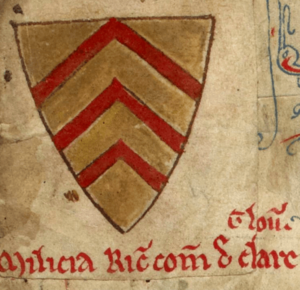Richard de Clare, 6th Earl of Gloucester facts for kids
Quick facts for kids
Richard de Clare
|
|
|---|---|

Arms of Richard referring to his knighting
|
|
|
|
| Reign | 1230–1262 |
| Predecessor | Gilbert de Clare, 4th Earl of Hertford |
| Successor | Gilbert de Clare, 6th Earl of Hertford |
| Other titles |
|
| Born | 4 August 1222 Clare Castle, Clare, Suffolk, Kingdom of England |
| Died | 14 July 1262 (aged 39) Waltham, Bridge Hundred, Lathe of Borough, Kent, Kingdom of England |
| Buried | Tewkesbury Abbey |
| Family | de Clare |
| Spouse |
|
| Issue |
|
| Father | Gilbert de Clare, 4th Earl of Hertford |
| Mother | Isabel Marshal |
Richard de Clare (born August 4, 1222 – died July 14, 1262) was an important English nobleman. He was the 5th Earl of Hertford, 6th Earl of Gloucester, and 2nd Lord of Glamorgan. His parents were Gilbert de Clare, 4th Earl of Hertford and Isabel Marshal. Richard also held significant power in Wales as a Marcher Lord. He took over the Lordship of Glamorgan after his father passed away. Richard played a big part in the political challenges that happened in England between 1258 and 1263.
Contents
Richard's Early Life
Richard became the Earl of Gloucester in October 1230, when his father died. Because he was still young, he was placed under the care of guardians. First, Hubert de Burgh looked after him.
Later, around October 1232, Peter des Roches became his guardian. In 1235, Gilbert, Earl Marshall, took over his care.
Richard's Marriages
Richard's first marriage was to Margaret, also known as Megotta. This marriage ended in November 1237, either because it was canceled or because she died. Both Richard and Margaret were only about 14 or 15 years old at the time.
Hubert de Burgh, Margaret's father, got into trouble in 1236 because this marriage happened without King Henry III's permission. Richard was still under the King's care. Hubert said he wasn't responsible for the marriage and promised to pay the King some money.
Even before Margaret died, another powerful noble offered King Henry 5,000 marks. This was to arrange for Richard to marry his own daughter. The King accepted this offer. So, Richard's second marriage took place on February 2, 1238. He married Maud de Lacy, who was the daughter of John de Lacy, 1st Earl of Lincoln.
Richard's Military and Political Role
In 1246, Richard joined other nobles in sending a letter to the Pope. This letter protested against unfair demands from the Pope's court in England.
He was also part of a group that opposed the King's half-brothers. These half-brothers visited England in 1247 and were not popular. However, Richard later made peace with them.
In 1252 or 1253, King Henry III went to Gascony with his army. Richard, however, chose not to go with the King. Instead, he traveled to Ireland, which made the King very upset.
Mission to Scotland
In August 1255, the King sent Richard and another official, John Maunsel, to Edinburgh. They were to investigate reports that Alexander III, the young King of Scotland, was being controlled by some of his nobles. Richard and his companion pretended to be knights of one of the Scottish nobles. They managed to get inside Edinburgh Castle.
Slowly, they brought in their own helpers until they had enough people to protect themselves. They spoke with the Scottish Queen, who told them she and her husband were being kept apart. Richard threatened the Scottish noble in charge, who then promised to go to the King.
Meanwhile, Scottish nobles were angry that Edinburgh Castle was controlled by the English. They planned to attack it. But they stopped when they realized their own King and Queen were inside. The King of Scotland then traveled south with Richard. By September 24, they were with King Henry III in Northumberland.
Illness and Recovery
In July 1258, Richard became very sick. People thought he and his brother William had been poisoned by their steward. Richard got better, but his brother William died.
Richard's Death and Legacy
Richard de Clare died on July 14, 1262, when he was 39 years old. He passed away at a manor in Waltham, near Canterbury.
His body was taken to Canterbury for a special church service. Then, it was moved about 45 miles (72 km) to a church in Tonbridge and buried there. Finally, on July 28, 1262, his body was moved again to Tewkesbury Abbey. He was buried with a grand ceremony next to his father. Richard's family symbol was three red chevron shapes on a gold background.
Richard owned many properties across different parts of England. After his death, official investigations were done to list all his lands and possessions.
Richard's Family
Richard de Clare did not have any children with his first wife, Margaret de Burgh.
With his second wife, Maud de Lacy, he had several children:
- Isabel de Clare (born around 1240 – died 1270); she married William VII, Marquess of Montferrat.
- Gilbert de Clare, who became the 6th Earl of Hertford and 7th Earl of Gloucester (born September 2, 1243 – died December 7, 1295).
- Thomas de Clare (born around 1245 – died 1287); he took control of Thomond in 1277. He married Juliana FitzGerald.
- Bogo de Clare (born around 1248 – died 1294).
- Margaret de Clare (born around 1250 – died 1312); she married Edmund, 2nd Earl of Cornwall.
- Rohese de Clare (born around 1252); she married Roger de Mowbray, 1st Baron Mowbray.
- Eglentina de Clare (died 1257); she passed away when she was a baby.
Richard's wife, Maud, received several important properties after his death. She built a beautiful tomb for him at Tewkesbury Abbey. She also arranged for her children to be married. Maud died before March 10, 1288 or 1289.
See also

